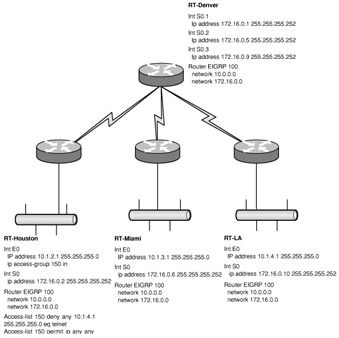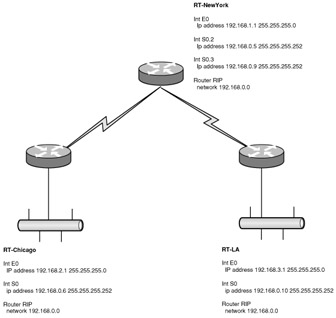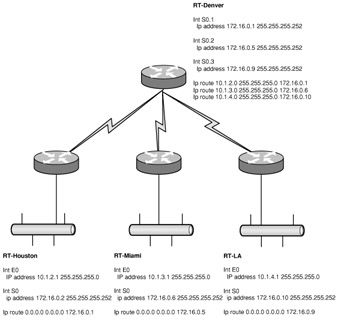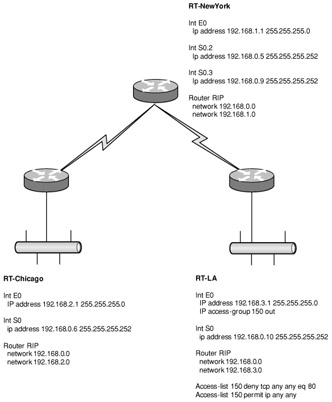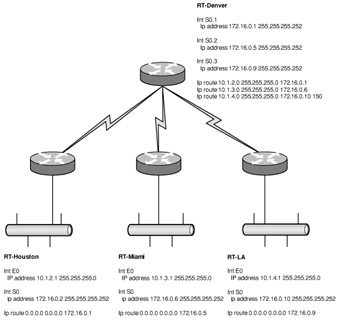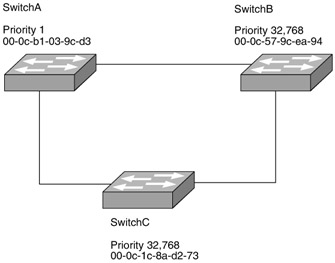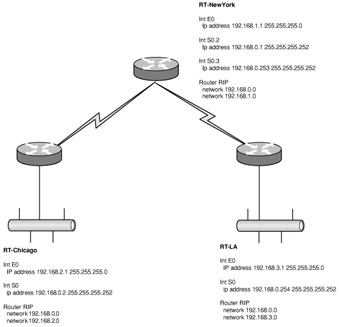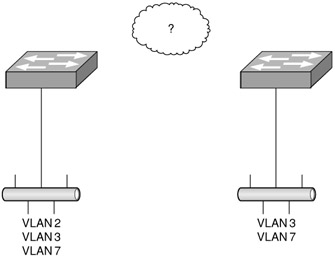CCNA-Practice Test 10
|
Directions: For each of the following questions, select the choice that best answers the question or completes the statement.
| 1. | You need to connect a company's new remote offices together. Three of their networks have at least 50 hosts each, and one network has only 10 hosts. They have multivendor routers connected by serial links and use separate subnets at each location. The company has one Class C address to use. Which of the following protocols is most appropriate for this scenario?
| |
| 2. | Which of the following statements is true regarding RIP routing?
| |
| 3. | Look at the following diagram. You have been asked to prevent users in Houston from telnetting into hosts at LA. You have configured the Houston router as shown but have been informed that the users in Houston still have telnet access to LA. What is the most likely cause of the problem?
| |
| 4. | Look at the following diagram. You have been asked to troubleshoot a problem. This network has failed to converge. What is the likely cause of the problem?
| |
| 5. | What will occur if two Cisco LAN switches are connected with a single crossover cable?
| |
| 6. | What wildcard mask should you apply to mask networks 172.16.8.0/21?
| |
| 7. | Look at the following diagram. The network has been configured using static routing and has been working fine. As configured, can a user in Miami ping the serial 0 interface in RT-LA?
| |
| 8. | You are reviewing the configuration files on a Cisco router that is configured to support PPP authentication. You notice the following command: ppp authentication chap callin. How does the router interpret this command?
| |
| 9. | _______________ are commonly used to divide a single collision domain by creating multiple smaller collision domains and are capable of supporting full-duplex transmission operation.
| |
| 10. | What is a disadvantage of using switches in your network?
| |
| 11. | Look at the following diagram. VTP does not seem to be working in this switched LAN. What is the most likely problem?
| |
| 12. | While reviewing your running configuration, you notice an access list line that reads access-list 10 deny 192.168.5.19. The wildcard mask field is notably absent. How is this access list line interpreted by the router?
| |
| 13. | What OSPF term refers to a network or router interface?
| |
| 14. | In which STP state does a port prepare to forward data frames without populating the MAC address table?
| |
| 15. | Which of the following commands is correct if you want to deny FTP from network 172.16.10.0 to network 172.16.20.0?
| |
| 16. | Which configuration register setting tells the router to look in NVRAM for the boot sequence?
| |
| 17. | Given the routing table entry below, which of the following options are used by default to calculate the number 32300? (Choose two.)
E 192.168.10.0 [90/32300] via 192.168.26.17,00:00:35 Ethernet 0
| |
| 18. | Which of the following describe the process identifier that is used to run OSPF on a router? (Choose two.)
| |
| 19. | Which types of OSPF network elect a backup designated router (BDR)? (Choose two.)
| |
| 20. | Which command sequence can you use to enable IP RIP version 1 on a router?
| |
| 21. | Which command sequence assigns the login password cisco on the console terminal line?
| |
| 22. | Describe the first step in data encapsulation.
| |
| 23. | You have purchased a layer 2 switch. Which of the following are true regarding switches? (Choose two.)
| |
| 24. | What is the IEEE version of spanning tree?
| |
| 25. | What are the ways that you can enter setup mode on a router? (Choose two.)
| |
| 26. | Look at the following diagram. You have been asked to prevent the LA users from accessing external web sites. You have configured the RT-LA router as shown but have been informed that users at LA still have access to external web sites. What is the problem?
| |
| 27. | Which of these commands are used to configure information into RAM on a router? (Choose three.)
| |
| 28. | Which of the following commands places a configuration from NVRAM into DRAM?
| |
| 29. | Which of the following are true regarding layer 2 switching? (Choose two.)
| |
| 30. | Look at the following diagram. You have been asked to troubleshoot a problem. This network has failed to converge. What is the likely cause of the problem?
| |
| 31. | If you have a layer-2 switch with 12 ports, and only 10 are in use, how many collision domains and broadcast domains do you have?
| |
| 32. | What is the subnet broadcast address that the host 192.168.10.17 with a mask of 255.255.255.240 uses?
| |
| 33. | What is the subnet broadcast address that the host 172.16.10.12 with a mask of 255.255.255.128 uses?
| |
| 34. | What is the valid host range of the IP subnet on which the address 172.16.10.61 255.255.255.224 resides?
| |
| 35. | What does the following command do?
RouterA#config net
| |
| 36. | What does the following command do?
RouterA#config mem
| |
| 37. | Look at the following diagram. You notice that someone has placed an administrative distance of 150 on the static route on RT-Denver used to reach the RT-LA LAN. What will the impact of this be?
| |
| 38. | If you want to change the default administrative distance for a static route to 150, what should you do?
| |
| 39. | Which command can you use to see the configuration register setting on a Cisco router?
| |
| 40. | You have large files that you need to transfer from your home to your remote corporate office. You need to do this periodically and quickly. What technology is best suited for your situation?
| |
| 41. | Look at the following diagram. Which switch will be become the root bridge?
| |
| 42. | If you want to see the DLCI number used by LMI for your router's management PVC, which command should you use?
| |
| 43. | When configuring a switch, what is the purpose of the ip address command?
| |
| 44. | What does a Frame Relay switch use to distinguish between each Permanent Virtual Circuit (PVC) connection?
| |
| 45. | Which OSPF network type establishes router adjacencies but does not perform the DR/BDR election process?
| |
| 46. | Which of the following solutions are used to reduce the chance of distance-vector routing loops? (Choose two.)
| |
| 47. | Look at the following diagram. You need to connect these two switches so that all hosts will be able to communicate with all other hosts on the same VLAN. Which of the following do you need?
| |
| 48. | When you enter router passwords during the setup dialog, what is the difference between the enable password and the enable secret password?
| |
| 49. | Look at the following diagram. You have been asked to configure the switch. Which of the following connections can you configure with portfast? (Choose three.)
| |
| 50. | You have just issued the erase startup-config command and reloaded your router. Which mode will your router be in when you reboot?
| |
| 51. | Look at the following diagram. You have been asked to troubleshoot a problem. This network has failed to converge. What is the likely cause of the problem?
| |
| 52. | You just entered the following command:
Router(config)#line console 0 Which operation is most likely to follow?
| |
| 53. | As data passes downward through the layers of the OSI model, it is encapsulated into various formats. Which of the following is the correct order of encapsulation?
| |
| 54. | The configuration register on your router is set to the factory default. What are the settings for the console port?
| |
| 55. | Look at the following diagram. You need to connect these two switches so that all hosts will be able to communicate with all other hosts. Which of the following do you need?
| |
Answers
| 1. | B Explanation: B. EIGRP should always seem like a good answer on a Cisco exam, but remember that it is proprietary, and the scenario given in the question involves multiple vendors. Also, the question states that the business requirements dictate (you have to read between the lines) that you need Variable Length Subnet Masks (VLSMs), so RIPv1 will not work. |
| 2. | B Explanation: B. Routing Information Protocol (RIP) is not good in large networks. When you configure RIP, you need to specify all directly connected networks you wish to route for in a classful manner. |
| 3. | B Explanation: B. The access list has an incorrect wildcard mask. It should be 0.0.0.255, not 255.255.255.0. |
| 4. | D Explanation: D. Although each of the three routers has the 192.168.0.0 network for the WAN segments, each router is missing the 192.168 network statement for the LAN segment. |
| 5. | D Explanation: D. To connect two switches together, you need a crossover cable. When a link is working on a switch, the port will be green. |
| 6. | D Explanation: D. The 0.0.7.255 wildcard mask corresponds to the /21 mask. |
| 7. | B Explanation: B. The Miami and LA routers both have default routes, and the Denver router knows about all subnets in the network (some connected, some through static routes). |
| 8. | A Explanation: A. When the command ppp authentication has been issued using the callin keyword, the router will authenticate a remote peer only if the remote peer initiated the call. |
| 9. | C Explanation: C. Only switches divide collision domains. Routers divide broadcast domains. |
| 10. | C Explanation: C. Because a switch does not create separate networks like a router does, if a broadcast storm takes place, a switch forwards the frames. |
| 11. | D Explanation: D. All switches that are participating in the same VTP domain must be configured with the same VTP domain name. In this diagram, each switch is configured to be part of a different VTP domain and thus will not share VTP information with the other switches in the figure. |
| 12. | A Explanation: A. The wildcard mask is optional when you are configuring a standard access list. If a wildcard mask is not specified, the router interprets the statement to be that the list is to match all bits of the source address. |
| 13. | A Explanation: A. Within OSPF, link is synonymous with interface. |
| 14. | B Explanation: B. An STP listening port listens to BPDUs to make sure no loops occur on the network before passing data frames. A port in the listening state prepares to forward data frames without populating the MAC address table. |
| 15. | B Explanation: B. When you are trying to find the correct answer from an access-list command string, always start by checking the access-list number. For extended lists that filter by upper-layer protocol, the number must be 100–199; this makes options A and C wrong. The next thing you need to check is the upper-layer protocol, which in this example is ftp. If you are filtering by FTP, the protocol field must be tcp. Only option B has the correct syntax. |
| 16. | D Explanation: D. The configuration register setting of 0x2102 tells the router to look in NVRAM for the boot sequence, which by default is to boot the IOS from flash and the configuration from NVRAM (startup-config). |
| 17. | B, F Explanation: B, F. 32300 is the composite metric for the route. EIGRP uses bandwidth and delay of the line, by default, to create the composite metric. |
| 18. | A, C Explanation: A, C. The process ID on a router doesn't do much; it just starts the OSPF routing protocol on your router. It is locally significant, which means that all routers can use the same number, or all different numbers-it doesn't matter. The only time this number matters is if you have an autonomous system boundary router (ASBR), which participates in two separate autonomous systems, and this is rare. |
| 19. | A, B Explanation: A, B. No DR is assigned on any type of point-to-point link. No DR/BDR is assigned on the NBMA point-to-multipoint due to the hub/spoke topology. |
| 20. | B Explanation: B. When you are configuring RIP, the networks are entered using classful notation (10.0.0.0, 172.16.0.0). |
| 21. | E Explanation: E. Option A sets the password for the virtual terminals (Telnet). Options B and C are invalid commands due to syntax errors. Option D has the correct command syntax, but it sets the password to CISCO. Passwords are case sensitive, so only the last sequence (option E) is correct. |
| 22. | C Explanation: C. The five encapsulation steps are as follows:
|
| 23. | B, D Explanation: B, D. Switches are considered multiple-port bridges by Cisco, and they filter by MAC address, not IP address. |
| 24. | D Explanation: D. IEEE 802.1D is the Spanning Tree Protocol specification. |
| 25. | B, C Explanation: B, C. Not that you would want to enter setup mode, but if you did, you could erase the contents of NVRAM by using the erase startup-config command and then rebooting the router. You can also type setup from privileged mode at any time. |
| 26. | A Explanation: A. This access list needs to be applied inbound on the Ethernet interface. When a user is attempting to communicate with a web server, their initial packet (which the router sees as inbound on the Ethernet interface) is destined for TCP port 80 on the web server. This access list, as applied, prevents users not in LA from connecting to any web sites hosted in LA. |
| 27. | A, B, F Explanation: A, B, F. The commands configure memory, configure terminal, and configure network are all used to configure information into RAM. However, copy startup-config running-config is the same as the older configure memory command. |
| 28. | C Explanation: C. The copy startup-config running-config command copies the contents of NVRAM into DRAM. |
| 29. | B, D Explanation: B, D. Layer 2 devices (switches) filter a network by using hardware addressing and create one large broadcast domain by default. Layer 2 devices also break up collision domains. |
| 30. | C Explanation: C. The WAN segments are part of the same Class C network, 192.168.0.0. This configuration will generate an error when applied to the RT-NewYork router regarding a duplicate IP address. A better solution would be to subnet the Class C. Further inspection of the addressing on the WAN links would show that the likely intention was to use a /30 mask. |
| 31. | B Explanation: B. Each switchport is its own collision domain; and, by default, each switch is one broadcast domain. |
| 32. | D Explanation: D. 255.255.255.240. 256 - 240 = 16; 16 + 16 = 32. Therefore, the subnet broadcast must be 192.168.10.31. |
| 33. | A Explanation: A. The subnet is 172.16.10.0, and the broadcast address is 172.16.10.127. This is determined by looking at the host ID, which is 12 in this case. Because it is less than 128, the subnet must be 0 in the fourth octet. |
| 34. | B Explanation: B. 256 - 224 = 32. 32 + 32 = 64. The subnet is 172.16.10.32, and the broadcast address is the number right before the next subnet (63 in this question). The valid hosts are the numbers between the subnet address and the broadcast address: 33 through 62. |
| 35. | C Explanation: C. config net is used to take a configuration stored on a TFTP host and merge it into running-config. |
| 36. | D Explanation: D. The config mem command is used to merge or restore a configuration from startup-config to running-config. |
| 37. | D Explanation: D. In this case, where no other dynamic routing protocols are running, modifying the AD on the static route will have no effect. If the router were running RIP or OSPF, for example, the static route would be effective only if that routing process lost the route. |
| 38. | C Explanation: C. By adding an administrative distance parameter to the end of a static route entry, you can change the default AD. |
| 39. | B Explanation: B. The show version command displays the current setting of the configuration register. |
| 40. | C Explanation: C. Even though a newer technology is probably a better choice at this point for home-to-corporate-office connections, Cisco's answer to this question is ISDN because of the periodic connection that is needed. |
| 41. | A Explanation: A. The priority of SwitchA is lower than that of the other two, and thus SwitchA will become the root bridge. The MAC address is relevant only if the priorities are all the same. |
| 42. | C Explanation: C. This is a hard one. To get the Local Management Interface (LMI) statistics for each Permanent Virtual Circuit (PVC) used on your router, use the show frame-relay lmi command. However, LMI uses a separate DLCI number between the router and Frame Relay switch, and this can be seen only with the show interface command. |
| 43. | B Explanation: B. This command assigns an IP address to the switch, which will be used to manage the switch. A switch does not need an IP address to work, but it will need one if you wish to telnet to it, for example. |
| 44. | A Explanation: A. Each PVC is assigned a Data Link Connection Identifier (DLCI) that uniquely identifies the virtual circuit over the connection between the router and the Frame Relay switch. The DLCI is only locally significant. |
| 45. | A Explanation: A. Broadcast and non-broadcast multi-access networks perform DR and BDR elections. |
| 46. | A, B Explanation: A, B. The split-horizon rule states that routers cannot send updates out on the same interface on which they were received. The route-poisoning rule dictates that routers must send out an update stating that the destination is unreachable when the link fails. |
| 47. | C Explanation: C. A crossover cable between the two switches, properly configured with a trunk link, will allow all users within any VLAN to communicate with each other. A router is only needed to communicate between separate VLANs, not within a single VLAN. |
| 48. | C Explanation: C. When you enter an enable secret password, it is encrypted and cannot be viewed in the configuration file. In addition, it will override the enable password, causing all users to use the enable secret password when attempting to enter privileged EXEC mode from user EXEC mode. |
| 49. | A, B, C Explanation: A, B, C. You can use the portfast command only on switchports with hosts or servers attached. |
| 50. | A Explanation: A. If the router cannot find a startup-config file, it will start the setup process. |
| 51. | B Explanation: B. In this case, all addressing and RIP configuration is correct. The most likely problem is IP subnet zero. If you notice, the 192.168.0.0 network has been subnetted using a /30 mask. The subnets in use on the WAN links are the first and last subnets. |
| 52. | C Explanation: C. When entering the line console command, you are entering the line mode where you can configure the console line. The only option presented that is a valid line-configuration task is creating a password. |
| 53. | C Explanation: C. The Transport layer is responsible for segmenting the data. The Network layer packetizes the segments received from the Transport layer. The Data Link layer is responsible for encapsulating the packet with framing information. The Physical layer is responsible for converting the bytes of the frame into bits and transmitting the bits across the physical media. |
| 54. | C Explanation: C. The default baud rate for the console port on a Cisco router is 9600bps. If the setting of the factory-default configuration register is changed, a lower baud rate can be selected. Data bits, parity, stop bits, and flow control are always set to 8, N, 1, and None and cannot be changed by modifying the configuration register settings. |
| 55. | A Explanation: A. In order to communicate between VLANs, you need a router. |
|
